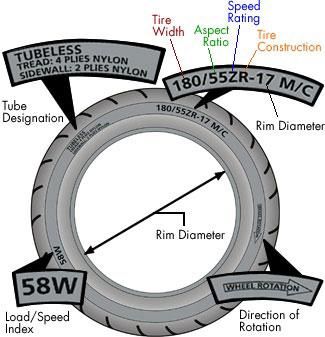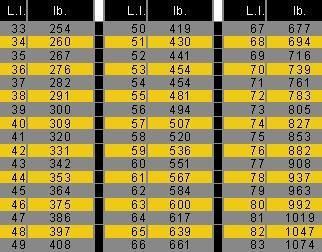Motorcycle Tires: The Basics
You would be amazed at the number of people that know only three things about the tires on their vehicles. They're round, rubber and black and every spring these people haul their beloved motorcycles out of the shed or garage, fire them up and hit the road. I wanted to share a few tips with you fine readers to hopefully provide some basic insight into tires or maybe a slight refresher for those already ‟in the know”.
Purchasing new tires:
The easiest path for this is a direct replacement of your existing tires; motorcycle manufacturers spend loads of time with tire companies to find the best suited tire for their particular bikes based on how that bike was intended to be used. Changing your tire size even marginally can affect every aspect of the bike and may be a safety concern. The downside can be that OEM tires can be expensive when purchased through the dealer, but you're not stuck like everything in life we do have options in the tire we choose the first piece of information required is knowing the year and model of your motorcycle. Any of the large part suppliers can source a wide range of tires suited for your motorcycle with this info, allow you to choose options that suit your riding style, from longer wear for touring to more performance on the track. The next piece of information is understanding your tire size dimensions. Modern tires have size data stamped on the side of the tire in this manner: XXX/XX x XX. The first number is the tires width in millimeters the second set is the tires aspect ratio (the height of the tires sidewall expressed as a percentage) to put it simple it's ratio of height to width. The third number is the wheel diameter in inches.
So let's look at the following example: 180/55 x 17
The 180 tells you the tire is 180mm at its widest point
The 55 tells you the tires height is 55% of its width (approx. 99mm)
The 17 tells you the tire is meant for a wheel of 17 inches in diameter
You may also see an F or R stamped into your tire, this is to ensure that the tire goes onto the right wheel. F is for Front and R is for Rear, lastly be sure to note the direction arrow this will tell you in which way the tire is intended to rotate as tread patterns are often designed to work in one direction.
Along with the size information you may also find a letter or two mixed in this is indicating type of construction: ‟R” (radial), ‟B” (bias belted) or ‟_” (bias).
An additional letter/number combo you might see on the tire's sidewall refers to the tire's load and speed index rating expressed as a two-digit number followed by a letter.
Speed-Rating Symbol - Speed Category
J - Up to 62 mph (100 km/h)
N - Up to 87 mph (140 km/h)
P - Up to 93 mph (150 km/h)
S - Up to 112 mph (180 km/h)
H - Up to 130 mph (210 km/h)
V - Up to 149 mph (240 km/h)
W - Up to 168 mph (270 km/h)
Z - Up to 149 mph (240 km/h)
Scooter - Up to 62 mph (100 km/h)

Basic-Tire-Info-Graphic

Motorcycle-Tire-Load-Index-Chart
Understanding of this information will provide you with a wealth of understanding and options in your tire selection.
So now you have your nice new tires on, what's next?
Tires are not maintenance free though most people may think something different. Tires do require some basic maintenance to ensure your safety and many miles of enjoyment on the roads and trails.
Tire pressure is the most important aspect of tire maintenance for a motorcycle, tires typically don't dump pounds of air overnight so a weekly check should be all that is required, a good tire gauge and pump or compressor will ensure your tires will be long lasting and work as they are intended.
Tire cleaning is also important it allows you to inspect your tires surface for any sign of damage but also removes and harmful chemicals that may have come into contact with the rubber and can degrade the material. For optimal cleaning stay away from any heavy duty cleaners or tire shine products intended for automotive use, even though you may think that shiny tires look awesome if these compounds get into contact with your tread you may find yourself in a slippery situation, mild soap and warm water is all that is really needed.
Since we in Canada typically only ride seasonally it is best to store your motorcycle in a clean, dry, well-ventilated area free from temperature fluctuations, be sure to maintain the correct tire pressure during the weeks/months you do not ride.
Here are some more important tips on tire inflation and general tire care from the Dunlop tire company:
-
For fully loaded or dual-riding touring-motorcycle applications, inflate tires to the maximum pressure recommended by the motorcycle manufacturer. And never exceed maximum load capacity indicated on the tire's sidewall or the motorcycles capacity load found in the owner's manual. A good rule of thumb is to use whichever maximum load recommendation is lower if the manual or tire sidewalls have different max capacities.
-
Underinflated tires can result in imprecise cornering, higher running temperatures, irregular tread wear, fatigue cracking, overstressing and eventual failure of the tire carcass, all of which could lead to, at some point, loss of control of the motorcycle.
-
Overinflating tires does not increase load-carrying capacity, but will result in a hard ride and accelerated tire wear in the center of the contact patch. Check cold tire pressure frequently with a good-quality gauge that holds a reading, and always before extended trips.
-
Loss of pressure may occur due to worn-out or badly seated valve cores. Check valve cores, and if necessary, tighten for correct seating, or remove and replace them. A metal or hard-plastic valve cap with an inner gasket should be used and installed finger-tight to protect the valve core from dust and moisture and to help maintain a positive air seal.